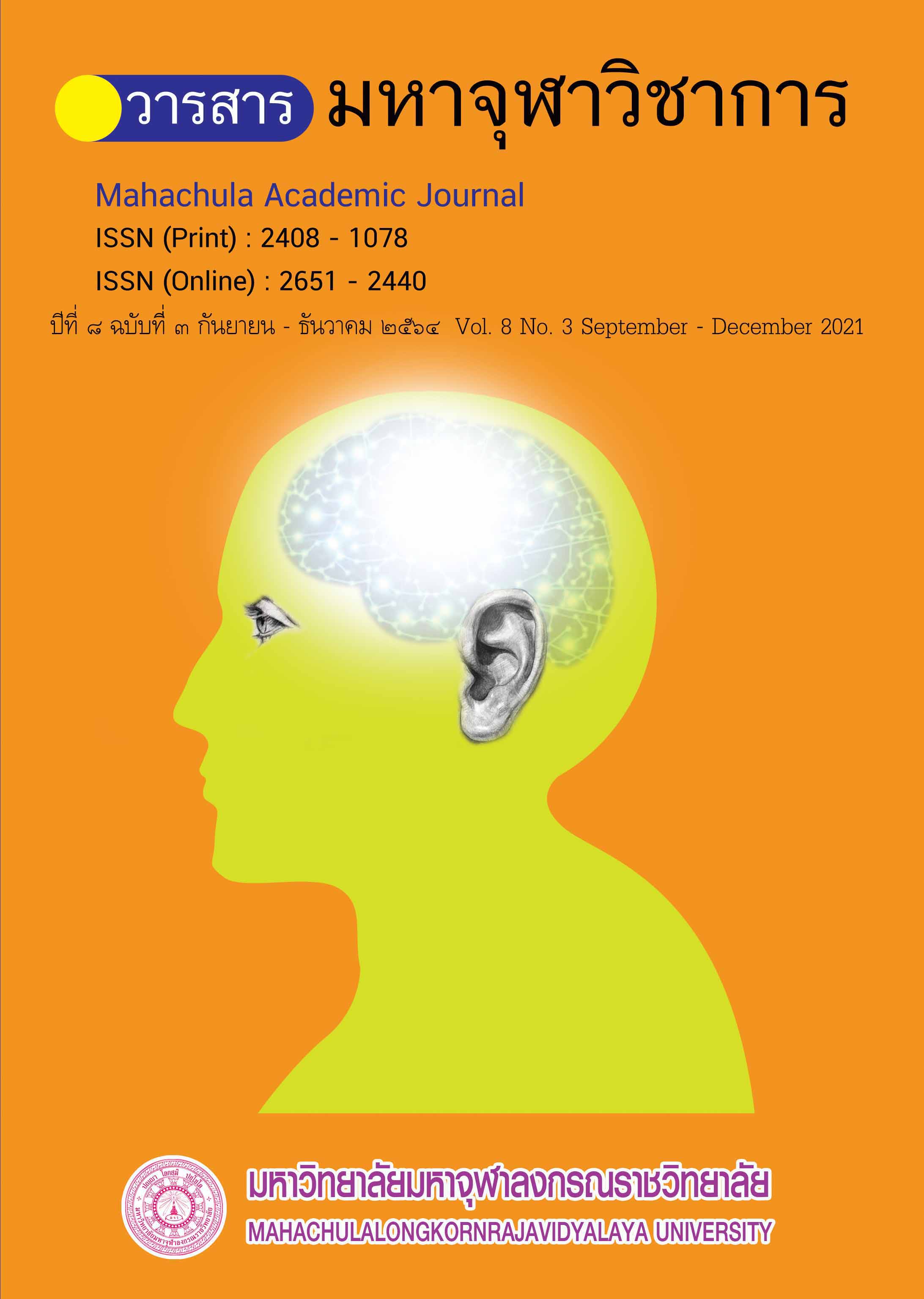A Study of the Insight Medition Practice in Buddhadāsabhikkhu’s View
Main Article Content
Abstract
This research entitled “A study of the Insight Mediation Practice in Buddhadāsabhikkhu’s view” has three objectives: (1) to study the principles and the practice of the insight mediation practice in Theravada Buddhism, (2) to study the insight mediation practice in Buddhadāsabhikkhu’s view, and (3) to analyze the insight mediation practice in Buddhadāsabhikkhu’s view. This is a documentary research which cover the contents in Tripitaka, commentaries, sub-commentaries and Buddhadāsabhikkhu’s involving literature and in-depth interviews of 5 Buddhadāsabhikkhu’s disciples.
The result of the research was found that the insight mediation practice in Buddhadãsabhikkhu’s view has the same details as the Mahãsatipatthãna Sutta (or the Discourse of 4 Foundations of Mindfulness) except the reference to Kayãnupassanãsatipatthãna (Mindfulness of the Body/Contemplation of the Body) in the parts of 32 bodily organs of sewage, 4 natural elements (earth, water, wind and fire), and corpses in 9 conditions (9 different cemeteries). But Venerable Buddhadãsabhikkhu applied Salãyatanavibhaṅga Sutta (the longer discourse on the six spheres Salãyatanavibhaṅga), Ānãpãnassati Sutta (the Discourse On In and Out Breathing) and the other 9 Dhamma principles which are consisted of Aniccatã (impermanence), Dukkhatã (state of suffering), Anattatã (soullessness), Dhammatthitatã (natural existence), Dhammaniyãmatã (Dhamma definition), Itappaccayatã (Concomitance), Tathatã (such beings), Suññatã (voidness) and Ataṁmayatã (the state of not being that) directly from Tipitaka for the short-cut Insight meditation practice. The mentioned insight meditation practice is taken for the enlightenment of temporary Nibbãna in the present. The Venerable Buddhadãsabhikkhu classified the insight meditation practice into two ways: (1) the natural insight meditation practice that persuades the practitioner to be separated from materialism and all facilities to support passions, desires, opinions, clinging to the world and to be bodily and mentally alone in order to see the really occurred Dharma conditions; and (2) the specific insight meditation practice concerning the sixteen-levels completes Ānãpãnassati that persuades the practitioner to apply the four Foundations of Mindfulness alternatives such as Mindfulness of the body, the feelings, the mind or mind-objects according to the really-occurred Dharma condition. Both of the insight meditation practice methods apply the same principles of Dharma in Buddhism such as Paticcasamuppãda, Ariyasacca 4 (4 Noble truths),Satipatthãnã 4 (the 4 Foundations of Mindfulness), Sammappadhãnã 4 (the 4 right efforts), Iddhipãdã 4 (the 4 roads to power), Indriyãni 5 (the 5 spiritual faculties), Balãni 5 (the 5 mental powers), Bojjhañgã 7 (the 7 factors of enlightenment), Ariyam atthañgikam maggam (the Noble Eightfold Path), Ataṁmayatã (the state of not being that) and Suññatã (voidness) or empty mind in Buddhadãsabhikkhu’s explanations. The results of the insight meditation practice in Buddhadãsabhikkhu’s view as Vipassanã results are able to reduce and eliminate one’s self and belongings, foolishness, craving, wrong thinking and clinging to materialism and all things for the ultimate extrication of sufferings in the presence of daily lives.
Article Details
References
สกู๊ปพิเศษ. “ม.หาดใหญ่เชิดชูเกียรติบุคคลสำคัญของโลก ร้อยใจใฝ่ธรรม รำลึก ๑๐๐ ปี พุทธทาส”. หนังสือพิมพ์ มติไทย. ปีที่ ๑๒ ฉบับที่ ๒๒๘ (๑๖-๓๐ เดือนมิถุนายน ๒๕๔๙).
กลุ่มอยู่เย็น เป็นประโยชน์. คู่มือเสียงธรรมพุทธทาส. ปทุมธานี: หอจดหมายเหตุพุทธทาส อินทปัญโญ, ๒๕๕๔.
ณฐภัทร อำพันธุ์. “วิธีการสอนหลักพุทธธรรมตามหลักวิทยาศาสตร์ของท่านพุทธทาสภิกขุ”. วารสารบัณฑิตศึกษาปริทรรศน์. ปีที่ ๑๓ ฉบับพิเศษ เล่ม ๑ (มิถุนายน ๒๕๖๐).
พระเจ้าบรมวงศ์เธอ กรมพระจันทบุรีนฤนาถ. ปทานุกรม บาลี ไทย อังกฤษ สันสกฤต. พิมพ์ครั้งที่ ๔. กรุงเทพมหานคร: โรงพิมพ์มหามกุฏราชวิทยาลัย, ๒๕๓๗.
พระธรรมโกศาจารย์ (พุทธทาส อินฺทปญฺโญ). อัตชีวประวัติของพุทธทาสภิกขุ เล่าไว้เมื่อวัยสนธยา. กรุงเทพมหานคร: มูลนิธิโกมลคีมทอง, ๒๕๕๕.
พุทธทาส อินทปัญโญ. ธรรมะ ๙ ตา. พิมพ์ครั้งที่ ๕. กรุงเทพมหานคร: สำนักพิมพ์อมรินทร์ธรรมะ บริษัท อมรินทร์ พริ้นติ้งแอนด์พับลิชชิ่ง จำกัด (มหาชน), ๒๕๕๘.
พุทธทาส อินทปัญโญ. วิธีฝึกสมาธิวิปัสสนา ฉบับสมบูรณ์. กรุงเทพมหานคร: บริษัท ไทยควอลิตี้บุ๊คส์, ๒๕๕๒.
พุทธทาส อินทปัญโญ. มรดกที่ขอฝากไว้. นนทบุรี: พิมพ์อำไพ, ม.ป.ป..
มหาจุฬาลงกรณราชวิทยาลัย. พระไตรปิฎกภาษาไทยฉบับมหาจุฬาลงกรณราชวิทยาลัย. กรุงเทพมหานคร: โรงพิมพ์มหาจุฬาลงกรณราชวิทยาลัย, ๒๕๓๙.
สมเจตน์ ผิวทองงาม. “การพัฒนาตนเพื่อความเป็นมนุษย์ที่สมบูรณ์ตามแนวทางพุทธทาสภิกขุ”. รมยสาร. ปีที่ ๑๕ ฉบับที่ ๓ (กันยายน - ธันวาคม ๒๕๖๐) : หน้า ๒๓-๓๐.


